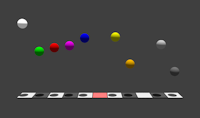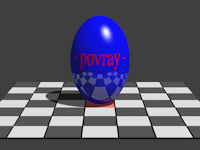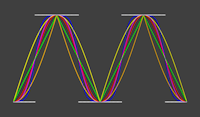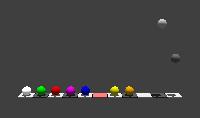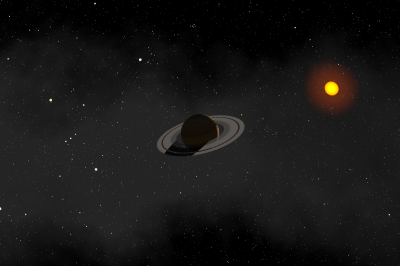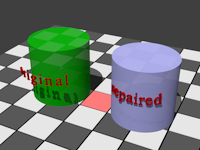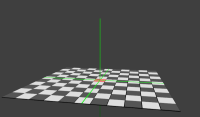Povray - Open Source --- MA_Helpers
When working with Povray I am missing many functions which are common in other programming languages. To sort arrays, handle strings, convert variable-types, lovely regular expressions, for all of that for example PHP provides about hundred functions. To handle strings Povray provides two helpful function only:substr() and strlen(). Thats it. Maybe in addition concat(), but thats it finally.
Variables
- Cam* and Lig*
Debug and Logfile
- MA_Terminal*
- MA_Error
- MA_Warning
- MA_Notice
- MA_Deprecated
- MA_Finish
- Important
Specialities
- MA_CameraAndLight_Prepare
- MA_CameraAndLight_Set
- MA_RenderStyle_Set
- MA_RenderStyle_Reset
- MA_GetParam_*
- MA_GetSlope
- MA_GetSlope_ByString
- MA_SetClock
- MA_OutputArrayString
- MA_Include
Strings
- MA_String_Pad
- MA_String_Trim
- MA_String_TrimChar
Mixed
- MA_Mixed_SumValues
Arrays - 1D
- MA_Array_FindString
- MA_Array_Merge
- MA_Array_Cut
Arrays - 2D
- MA_Array2D_Merge
- MA_ArrayString2D_FindRow
- MA_ArrayString2D_FindRow_Multi
- MA_ArrayString2D_Sort
- MA_ArrayString2D_MergeAndSort
Converts
- MA_String2Array
- MA_ArrayString2String
- MA_ArrayFloat2String
- MA_String2Vector
- MA_ArrayString2Vector
- MA_Vector2String
- MA_Vector2String_Base
- MA_Deg2Vector*
- MA_Vector2Deg
Repaired or complemented Povray-Macros
- MA_Circle_Text_Valigned
Experimental / Development
- MA_Testarea
- MA_CenterMarker
Download
These are far away what I needed, so in the past years I coded many macros by hand. Costs much time but maybe it will save otherones time by publishing them here.
Without ma_helpers.inc no one of my bigger scripts will work!
The file has to be included everywhere, otherwise you can count the error-messages. Despite its size of nearly 3000 rows (October 2024) it doesnt lower the render-performance, not even a second of parse-time will come on top.
For a more detailed documentation of the macros and what finally will be the result see the sourcecode.
- Cam* and Lig*
Debug and Logfile
- MA_Terminal*
- MA_Error
- MA_Warning
- MA_Notice
- MA_Deprecated
- MA_Finish
- Important
Specialities
- MA_CameraAndLight_Prepare
- MA_CameraAndLight_Set
- MA_RenderStyle_Set
- MA_RenderStyle_Reset
- MA_GetParam_*
- MA_GetSlope
- MA_GetSlope_ByString
- MA_SetClock
- MA_OutputArrayString
- MA_Include
Strings
- MA_String_Pad
- MA_String_Trim
- MA_String_TrimChar
Mixed
- MA_Mixed_SumValues
Arrays - 1D
- MA_Array_FindString
- MA_Array_Merge
- MA_Array_Cut
Arrays - 2D
- MA_Array2D_Merge
- MA_ArrayString2D_FindRow
- MA_ArrayString2D_FindRow_Multi
- MA_ArrayString2D_Sort
- MA_ArrayString2D_MergeAndSort
Converts
- MA_String2Array
- MA_ArrayString2String
- MA_ArrayFloat2String
- MA_String2Vector
- MA_ArrayString2Vector
- MA_Vector2String
- MA_Vector2String_Base
- MA_Deg2Vector*
- MA_Vector2Deg
Repaired or complemented Povray-Macros
- MA_Circle_Text_Valigned
Experimental / Development
- MA_Testarea
- MA_CenterMarker
Download
Variables
In the upper part of the file are some dozens variables located to control and modify the behavior of the macros. Before you copy-paste the macros into your code and modify them have a look into the file. Also in some of my other scripts the existense of this variables is mandatory.
Cam* and Lig*
All Variables:CamLocation, CamLookAt, CamAngle, CamRotate, CamSky, CamType, LigVector, LigColor, LigIntensity, LigRotate The values of this variables come to live in the macro MA_CameraAndLight_Set(). With their help all parameters of camera and light can be changed multiple times without calling the original povray-function every time. Also some nice things like automatically fade-in and -out will become possible (later, under construction). Simple example:
#declare CamAngle = 60;
doSomething()
#declare CamRotate = <10,0,0>;
MA_CameraAndLight_Set()
Debug and Logfile
MA_Terminal* ( mText [, mValue] )
MA_Terminal ( mText )
MA_Terminal_S ( mText, mValue )
MA_Terminal_F ( mText, mValue )
MA_Terminal_V ( mText, mValue )
MA_Terminal_AS ( mText, mValue )
MA_Terminal_AF ( mText, mValue )
MA_Terminal() sends a simple text/string to the terminal. If you like to concat a variable behind it use some of the other macros. Povray isnt able to convert types by itself so for every variable-type exists its own macro. So use MA_Terminal_S() for strings, _F for float, _AS for string-arrays and so on.Is a nice to have in complex scripts to output the value of variables fast and easy.
MA_Error ( mMacro, mText )
MA_Warning ( mMacro, mText )
MA_Notice ( mMacro, mText )
Very similar to MA_Terminal_S but the parameters are the same as for warning and error (them above).
MA_Deprecated ( mOldMacro, mNewMacro )
#macro Old_Macro (mVar1, mVar2)
MA_Deprecated ("Old_Macro", "New_Macro")
New_Macro (mVar1, mVar2 + 4711)
#end
*** MA => *** DEPRECATED ***: Macro 'Old_Macro' is old and risky, use 'New_Macro' instead!!!
MA_Finish ()
Should used - if at all - at the end of the executed script.
Important
I use this macros often in my scripts. Somewhen in the future I like to output their content into a logfile. With this small helper-macros I only need to modify them instead of hundreds of lines in dozens of scripts.
The disadvantage of using them clearly is that they do not spit out the real linenumbers. If you like to get informed about the linenumber and the calling file you should forget most of the above macros and make use of povray-directives #debug, #warning and #error.
See: http://povray.org/documentation/3.7.0/r3_3.html#r3_3_2_7_1
Specialities
MA_CameraAndLight_Prepare ()
MA_CameraAndLight_Set ()
An example how to use both of the functions will follow.
MA_RenderStyle_Set ( mStyle )
MA_RenderStyle_Set("hell")
//MA_RenderStyle_Set("dev")
sphere { 0,1
texture {
#if (RS_Dev) pidgment { color Gray10 } #end
#if (RS_Tec) pidgment { color Green } #end
#if (RS_Real) pidgment { color Silver } #end
#if (RS_Hell) pidgment { color Silver2 } #end
}
}
MA_RenderStyle_Reset ()
MA_RenderStyle_Set("real") // or "dev", whatever.
object { Get_far_away_object__No_need_to_be_too_detailed() }
MA_RenderStyle_Set("hell")
object { Get_something_very_near_with_all_possible_details() }
MA_RenderStyle_Reset()
object { Get_another_far_away_object() }
MA_GetParam_* ( xParams, xParamName, mDefault ) => float/string/vector/boolean
MA_GetParam_S ( xParams, xParamName, mDefault ) => string
MA_GetParam_F ( xParams, xParamName, mDefault ) => float
MA_GetParam_V ( xParams, xParamName, mDefault ) => vector
MA_GetParam_B ( xParams, xParamName ) => boolean
Povray doesnt know about optional parameters or other useful ways to send a variable number of values/parameters to a macro. This problem solves MA_GetParam_*() in an old-fashion way.
Similar to CSS parameters and values become separated with a colon (:). This pairs will arranged by semicolon (;) with other pairs and saved in one string-variable. This string can be send to macros which uses the MA_GetParam_*()-Makros to pick out whats needed. Especially if macros call other macros and are out of range from the outside this method its useful to pass them to sub-macros.
At the bottom of the include-file ma_helpers you can find an example and my Spaceship #declare myParams = "position: <0,1.5,0>; color: <0,0,1>; scale-y: 1.5; text: - povray -; reflection";
#macro ShowSphere (mParams)
#local mPos = MA_GetParam_V(mParams, "position", <0,5,0> );
#local mColor = MA_GetParam_V(mParams, "color", <0,0,0> );
#local mScaleY = MA_GetParam_F(mParams, "scale-y", 1 );
#local mText = MA_GetParam_S(mParams, "text", "-none-" );
#local mReflection = MA_GetParam_B(mParams, "reflection" );
#ifndef( Shapes_Temp) #include "shapes.inc" #end
union {
sphere { 0, 1
texture { pigment { color mColor } }
#if (mReflection) finish { reflection 0.1 phong 1} #end
}
object {
Circle_Text_Valigned (
"timrom.ttf", mText, 0.5, 0.0005, 0.05, 1, 1, Align_Center, -90, -90
)
texture { pigment{ color rgb <1,0,0> } }
rotate<90,0,0>
}
scale <1, mScaleY, 1> translate mPos
}
#end
ShowSphere (myParams)
MA_GetSlope ( xValue, mType, mIterations, mOffset ) => float
Next version.
MA_GetSlope_ByString ( xValue, mTypeMixed ) => float
round
linear
cosine
cosine+
cosine++
bounce+
bounce-
bool
Same functionality as MA_GetSlope(), but the three slope-parameters can delivered in a colon- or semicolon-separated string. Included optional parameters, iterations and offset can be leaved out.linear
cosine
cosine+
cosine++
bounce+
bounce-
bool
MA_Terminal_F ("slope-1", MA_GetSlope_ByString(0.7, "linear,1,0"))
MA_Terminal_F ("slope-2", MA_GetSlope_ByString(0.7, "cosine+;4;-0.5"))
MA_Terminal_F ("slope-3", MA_GetSlope_ByString(0.7, "bounce+")) //bounce+,1,0
#local mySlope = MA_GetSlope_ByString(0.7, ""); //linear, 1,0
MA_SetClock ( mValue )
#if (clock_on = false)
#local myClock = 0.5;
#else
#local myClock = clock;
#end
object { sphere { 0,1 } translate <0, 5 * myClock, 0> }
MA_SetClock(0.5)
object { sphere { 0,1 } translate <0, 5 * MA_Clock, 0> }
MA_OutputArrayString ( mArray, xFile, mOverwrite, mComment )
MA_OutputArrayString_Base ( mArray, xFile, mOverwrite, mComment, mHighestIndex )
Saves a string-array well formatted into a textfile. Really nice if you like to see what really happens in it. If you save more than one array in one file you can comapare the content befor and after other operations, maybe after sorting. For that at the first time set Overwrite = true and the others false. The Comment will be saved above the array and helps with identification.
MA_Include ( mFile, mBasePath ) => string
Returns the path where the file was found, otherwise "-1" as a string.
#local mFolderSkyfakes = MA_Include("ma_skyfakes.inc", "");
#if (mFolderSkyfakes != "-1")
MA_Terminal("Skyfakes found")
#include concat(mFolderSkyfakes, "ma_skyfakes_textures.inc")
#else
MA_Terminal("Skyfakes NOT found")
#end
Strings
MA_String_Pad ( xString, mLength, xPadChar, mPadPos ) => string
#local Test = MA_String_Pad("Bongo", 10, "-", "l"); // returns "-----Bongo"
#local Test = MA_String_Pad("Bongo", 8, "-", "right"); // returns "Bongo---"
MA_String_Trim ( mParam ) => string
MA_String_TrimChar ( mParam, mChar ) => string
Mixed
Mixed variables in my world are vectors that are stored as strings. I need this often to store strings, numbers, and vectors in a string array. A Vector <1,2,3.3> becomes Mixed "1,2,3.3".
MA_Mixed_SumValues ( mMixed1, mMixed2 ) => string/mixed
#local m1 = "1,2,300";
#local m2 = "3, 4.5, -17";
#local mSum = MA_Mixed_SumValues (m1, m2); //will return string "4, 6.5, 283"
Arrays - 1D
MA_Array_FindString ( mString, mArray ) => boolean
#local City = "cologne";
#if (MA_Array_FindString(City, array[3] { "Bielefeld", "Cologne", "Posemuckel" }))
MA_Terminal_T ("Yes man")
#end
// or ...
#if (!MA_Array_FindString(City, array[3] { "Bielefeld", "Cologne", "Posemuckel" })) ...
MA_Array_Merge ( mArray1, mArray2 ) => array
MA_Array_Cut ( mArray, mIndexFirst, mIndexLast, mRows ) => array
Use IndexFirst and Rows OR IndexFirst and IndexLast and set the not used parameter = 0.
Arrays - 2D
MA_Array2D_Merge( xArray1, xArray2 ) => 2d-array
Can be used with all types of variables inside the arrays.
MA_ArrayString2D_FindRow ( mArray, mString, mCol ) => float
If the string is found the macro returns the index of the row (0-based) or -1 if nothing was found.
#declare test = array[4][2] {
{ "berlin", "3000000" }
{ "hamburg", "2000000" }
{ "cologne", "1000000" }
{ "munich", "500000" }
}
MA_Terminal_F("found row", MA_ArrayString2D_FindRow ( test, "cologne", 0)) //Output: 2
MA_ArrayString2D_FindRow_Multi ( mArray, mString1, mString2, mCol1, mCol2, mIndexFirst, mIndexLast ) => float
MA_ArrayString2D_Sort( mArrayOld, mColSort, xDirection, xCompType ) => 2d-array
MA_ArrayString2D_MergeAndSort( xArray1, xArray2, mColSort, xDirection, xCompType ) => 2d-array
Converts
MA_String2Array ( mString, mSep, mTrim ) => array
Use Trim (true/false) to delete leading or trailing spaces.
MA_ArrayString2String ( mArray, mSep ) => string
MA_ArrayFloat2String ( mArray, mSep ) => string
MA_String2Vector ( mString ) => vector
MA_ArrayString2Vector ( mArray ) => vector
MA_Vector2String ( mVector ) => string
MA_Vector2String_Base ( mVector, mDimensions, mDigits ) => string
MA_Deg2Vector* ( mRA, mDE, mRadius ) => vector
MA_Deg2Vector00 ( mRA, mDE, mRadius ) => vector
MA_Deg2Vector10 ( mRA, mDE, mRadius ) => vector
MA_Deg2Vector01 ( mRA, mDE, mRadius ) => vector
MA_Deg2Vector11 ( mRA, mDE, mRadius ) => vector
Converts right ascension RA and declination DE together with the distance Radius to a vector.
Normally the values for RA ranges from -180 to 180 and DE from -90 to 90 degree, but that can differ from the source where you get the data from. If the data contains only positive values for RA and DE use the macro MA_Deg2Vector00(), in all other cases the both digits at the end stands for a true/false, if the values have to shifted to the positive range. MA_Deg2Vector10() will add 180 to all RA values, MA_Deg2Vector01() will add 90 to all DE values, and so on.
Internally the macro calculates with radians, which only works with positive values.
MA_Vector2Deg ( mVector ) => array
Who ever knows how to invers the following calculation ... I really would like to get the solution.
#macro MA_Deg2Vector (mRA, mDE, mRadius)
#local mRect = radians(mRA + MA_Deg2Vector_RA_Offset);
#local mDecl = radians(mDE);
//Here we have the critical lines
#local mPosX = mRadius * sin(mDecl) * cos (mRect);
#local mPosY = mRadius * cos(mDecl);
#local mPosZ = mRadius * sin(mDecl) * sin (mRect);
#local mVector = <mPosX, mPosY * -1, mPosZ>;
mVector
#end
Repaired or complemented Povray-Macros
MA_Circle_Text_Valigned ( ... ) => object
I am not totally sure if its a bug or a mis-use by myself, so I created this macro, which is to 99% a copy of the original, with only a few lines modified. Parameter and return-value are the same. See also Shapes.inc in the povray-documentation. Example:
union {
cylinder {
<0,0,0>, <0,2,0> 1
texture { pigment { color rgb <1,1,0> transmit 0.2 } }
}
object {
//Circle_Text_Valigned (
MA_Circle_Text_Valigned (
"timrom.ttf", "huhu", 0.5, 0.0005, 0.05, 1, 1, Align_Center, -90, -90
)
texture { pigment { color rgb <0.5,0,0> } }
rotate<90,0,0>
translate <0,1,0>
}
}
Experimental / Development
There is no guarantee by myself, that the following macros will survive a long time.Use them on your own risk.
MA_Testarea ( mAll )
MA_Testarea_Base ( mXN, mXP, mZN, mZP )
Shows a chess-like testbed.The parameters defines the number of tiles in the different directions (x-axis negative, x-axis potitive, the same for z).
MA_CenterMarker ( mLengthAxes )
MA_CenterMarker_Base ( mRadiusSphere, mThicknessAxes, mLengthAxes, mAxes )
Marks <0,0,0> with a sphere and the axes with lines.
Download
ma_helpers.7z => 560 kB 7-Zip - Version 1.0 from 29th December 2024ma_helpers.zip => 580 kB Zip - for the Ladies
Comments
No comments at all, sorry.
* E-Mail and Website optional, E-Mail will not get published, use this only if you like to get an answer.
the german site
the english site
both sites
the english site
both sites


